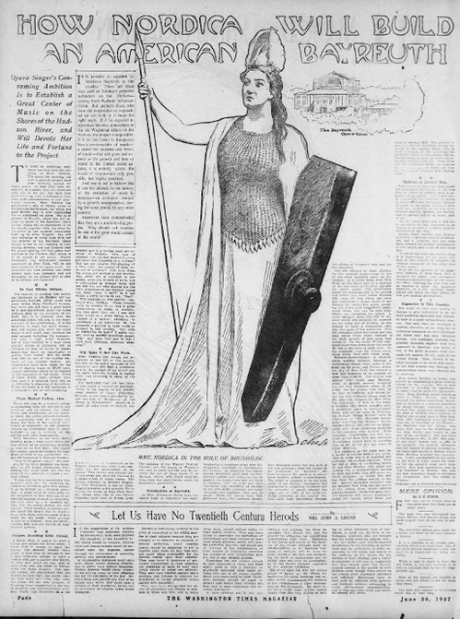
Lillian Nordica en 1892

Si le village de Harmon existe bel et bien aujourd'hui sous le nom de Croton-on-Hudson (8000 habitants en 2010), le projet de théâtre et d'école musicale ne vit cependant pas le jour. Lillian Nordica, très occupée par sa carrière, sa nouvelle maison à Deal Beach (New Jersey) et les préparatifs de son (quatrième) mariage avec George W. Young, un riche banquier, perdit progressivement l'intérêt qu'elle portait au projet et y renonça en 1909.
Nous présentons ici en introduction une coupure de presse du Figaro de 1910 qui évoque la carrière de la chanteuse jusqu'à cette date. Ensuite nous reproduisons quelques coupures de la presse française et américaine qui ont rendu compte du projet de Bayreuth américain.
La carrière de Lillian NORDICA. Un article du Figaro du 19 octobre 1910.
Tous ceux qui furent les hôtes de Bayreuth, du Prinz-Regent de Munich, la connaissent et l'admirent; tous ceux qui pénétrèrent dans les milieux artistiques de New-York, de Berlin ou de Londres savent quels impérissables souvenirs elle y a laissés.
Qui n'a conservé, dans ces villes, la mémoire des représentations inoubliables où la Nordica était Juliette alors que Jean de Reszké incarnait Roméo, où Gilda avait pour duc de Mantoue Caruso, où Lilli Lehmann, Ternina, Fremstad, Schuniann-Heink, Van Dyck; Scotti, Plançon, Journet étaient ses partenaires.
Lillian Nordica est aujourd'hui une des plus remarquables interprètes du répertoire wagnérien, comme elle est une des plus belles chanteuses de notre temps. Sa facilité, la souplesse de son talent est proverbiale aujourd'hui elle incarne la volage Traviata de Verdi, demain la majestueuse Brunnhilde de Wagner; dans Don Juan elle apparut successivement sous les traits de Zerline, de Donna Anna, d'Elvire. Son répertoire est immense: la créatrice d'Elsa, à Bayreuth, a interprété, sauf Eva des Maîtres chanteurs, tous les rôles wagnériens; elle possède le répertoire italien et français tout entier, de Faust et Roméo à Carmen, en passant par les Huguenots, Hamlet, et la Gioconda.
C'est elle que la direction de l'Opéra nous fera entendre mercredi aux côtés de Van Dyck dans ce rôle d'Isolde où son art atteint au pathétique le plus émouvant.
Détail à noter l'interprète illustre d'Isolde a tenu, par un geste de haute courtoisie et de merveilleuse volonté, à apprendre ce rôle en français, exprès pour le chanter devant le public parisien.
Le projet du Bayreuth américain. Coupures de la presse française
- Le Radical, Paris, 13.06.1907 (p.4)
Le projet de Mme Nordica de construire, sur les bords de l'Hudson un Bayreuth américain, qui comprendra un « Festspielhaus » exactement copié sur les plans de celui de Bayreuth et une école de chant où les jeunes Américain et Américaines trouveront des professeurs européens en renom a de grandes chances de se réaliser.
La grande cantatrice a assumé à sa charge les frais de construction de l'immeuble, qui sera situé à quarante milles de New-York, dans un des endroits les plus pittoresques des jolis bords de l'Hudson ; et, pour assurer, l'avenir de son entreprise, elle a su intéresser a son idée plusieurs amis fortunés et quelques milliardaires, MM. Rockefeller et Pierpon Morgan entre autres.
La première année, on n'y jouera que des œuvres wagnériennes; ensuite viendra un cycle d'oeuvres de Shakespeare qui seront interprétées dans un théâtre en plein air. Le dimanche après midi, on exécutera, au Festspielhaus, des oratorios et des œuvres symphoniques ; le dimanche soir on y donnera des représentations populaires.
Mme Nordica est en route pour l'Europe, où elle essaiera d'intéresser à'son œuvre le monde musical des principales capitales. Elle ira d'abord à Paris, de là à Bayreuth où elle invitera Mme Cosima Wagner et M. Siegfried Wagner à l'inauguration de son théâtre qui aura lieu en juin 1909, et ensuite à Berlin, Vienne, etc.
- Le Ménestrel : journal de musique, Paris, 06.07.1907
- Le Ménestrel : journal de musique, Paris, 12.10.1907
Le projet du Bayreuth américain. Coupures de la presse américaine
- Wahington Times et Brooklyn Daily Eagle du 30 juin 1907

Article du 30 juin 1907 dans le Washington Times et le Brooklyn Daily Eagle
- Waterbury evening Democrat du 10.09.1907 (p. 7)

An American Bayreuth on the Hudson, an institution which shall grow to be the center of students of music, and a place where lovers of classical music will be able to gratify their aesthetic tastes to the full, is the dream of Mme Nordica, and she has avowed her purpose to bring that dream to realization. The close friends of the prima donna know that the plans for carrying out such a gigantic project have been carefully nursed for many years. At first they were immature;in a sense they are immature still; but in the last few days they have taken on such a substantial form that their consummation is now practically assured. Mme Nordica has purchased a site of 20 acres at Harmon-on-the-Hudson, for which she paid $100,000,. and is now negotiating for an additional ten acres. She is at present in Munich, where she will secure the plans of the Bayreuth opera house, which will be reproduced in all its details, together with the other institutions in the musical community built by Frau Wagner. She will also endeavor to bring back with her the director of the Bayreuth opera house to act in the capacity of consulting director, and has planned that the grand opening will take place next summer in the Festival hall, which is to be named in her honor. Walter Damrosch, the well-known musical director of New York, will be the first conductor of the Opera house. An architect has ben secured, and other details have been arranged and are arranging; so the project may be said to be already well launched.
The expense of building this American Bayreuth on the Hudson will approximate $ 1.000.000, which could well come within Mme. Nordica's fortune, but while she will bear a good share of it and has already made the initial outlays, such as the purchase of the land, etc., it is believed that the American public will join in the financial part of the undertaking. It is the intention to make the opera season, -and this season will, after the institution is well under way, continue the year around, including the summer not only a high social function, but to have included in it days when popular prices of admission will be charged, so that all lovers of classic music may have an opportunity to gratify their tastes. But the social part will be one of the leading features or the musical festival.
Arrangements have been made for the sale of 16 boxes at $ 25.000 each, regular admission prices to be charged to the occupants of the boxes. Three of these boxes have already been sold, and it is believed there will be no difficulty in disposing of the others. When the opera is in full operation, it is believed it will be self-sustaining.
There will also be a musical college In connection with the Institution and buildings will be erected for class rooms and dormitories for the pupils. In short, the entire plan -theoretically and practically - will be carried out along the lines of the musical institution at Bayreuth.It will probably require an endowment fund of about $ 3.000.000 to id in carrying of the schools and other departments,
Mme. Nordica will devote the remainder of her life to this project. She will be the active manager of the enterprise and will take a prominent part in the conduct of the school and the opera festivals, singing in leading roles, and attending to many of the details.
The institution that she has taken as her model is located at Bayreuth, which is the capital of the government district of Upper Franconia, Bavaria, at one time a principality under the rule of Margraves, of the house of Hohenzollern. Bayreuth is about 125 miles north of Munich, and is the Mecca of the Wagnerites. as the Wagner theater was built there especially for the performance of his operas. This theater was erected 32 years ago, on a hill, reached by a broad street of shady trees. The former residence or Richard Wagner, the Villa Wahnfried, Is not far away. Wagner Is buried in the grounds. There to also the house of Jean Paul Richter. whose body lies in the Central cemetery near that of Frans Liszt. The building of the Wagner Festival theater was the dream of Wagner's life, and to carry out his plans he secured the aid of King Louis II of Bavaria, which, with small subscriptions from the music lovers, made the proposition practicable.
As Mme. Schumann-Heink says, one can not hope to reproduce the exact Wagnerian atmosphere along with the Wagnerian buildings at Harmon-on-the-Hudson. At Bayreuth the artists almost invariably give their services without charge and follow as far as possible the instructions and ideas of Wagner. For the most part they discourage any exhibition of emotion on the part of the audience, and never recognize any applause that may be given. When the operas were first produced there, the audiences in variably remained silent, but this rule is not now generally observed, except in the production of "Parsifal." On those occasions the object is to secure every possible artistic reinforcement. The singer is supposed to be the mere agent of the literary expression, the auditorium is completely darkened and the orchestra is placed beneath the stage, out of sight of the audience. These traditions of the musical festival have been maintained through the efforts of Wagner's wife and his son Siegfried.
The site selected by Mme. Nordica for her musical conservatory is one of the most beautiful spots on the Hudson. It is 30 miles from New York on the direct line of a railroad on the east bank of the river opposite the Jersey shore. The prominence where the buildings are to be erected and which has been called Nordica Hill, rises 250 feet above sea level and commands a broad sweep of the Hudson for 25 miles, unrolling one of the most magnificent panoramic views that can be seen anywhere, not excepting the Rhine. A short distance from this hill is another which will probably be reserved for the home site of Nordica, as she intends to build a substantial villa near the scene of her endeavors. This hill comprises about five acres and has been called Piney Point, because of the thick growth of pine.trees.that covers it. To the north of this eminence, there runs down sheer for nearly 200 feet a precipice of solid rock. To the south east runs the Croton river, along banks lined with forest trees.
- Début d'un article du Los Angeles Herald du 06.06.1907

Los Angeles herald.,
June 06, 1907, p.1
- Publicité du promoteur immobilier dans The Evening World du 22 juin 1907. La mention Site selected by Madame Nordica for the "American Bayreuth" est à remarquer.

- Réclame du promoteur immobilier dans The Sun du 7 juillet 1907. Il y reproduit un télégramme du bayrton américain David Bispham félicitant la chanteuse pour son projet. Bispham annonce avoir acquit une large parcelle à Harmon. Bispham interpréta notamment les rôles de Beckmesser et de Kurwenal.

Réclame dans The sun du 7 juillet 1907
- Réclame du promoteur immobilier dans The Evening World du 25.06.1951: Annonce d'une excursion gratuite à Harmon pour visiter le site au départ de Grand Central Station (New York City). Remarquons la mention du "American Bayreuth".

- Réclame dans le Washington Times du 07.07.1907

Réclame publiée dans le Washington Times du 7 juillet 1907
L'abandon du projet du Bayreuth américain au printemps 1909
- Le Ménestrel : journal de musique, 01.05.1909, p.6

